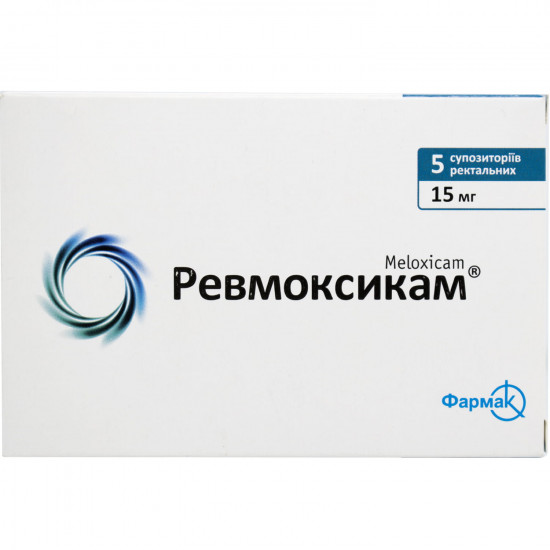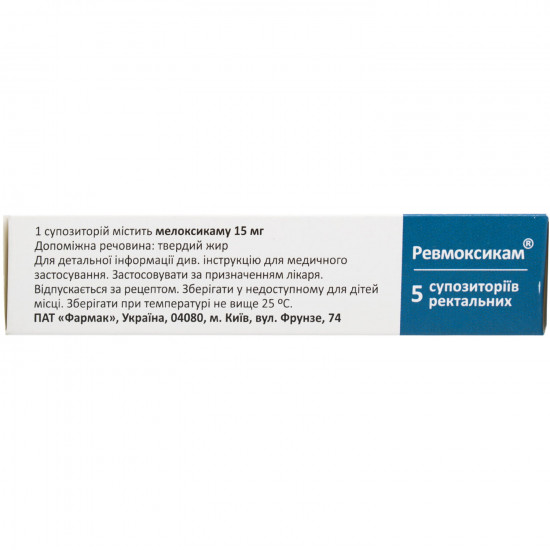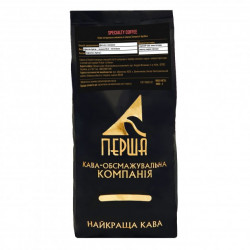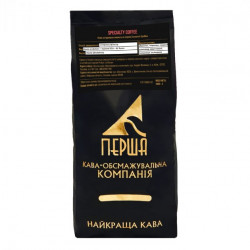



- Stock: In Stock
- Model: 183553
0% Customers recommend this product
-
5 Awesome0%
-
4 Great0%
-
3 Average0%
-
2 Bad0%
-
1 Poor0%
Reviews Over Revmoksikam soup. rektat. 15 mg No. 5
- (0)
Total Reviews (0)
click here write review to add review for this product.
Report this review.
Description
Pharmacological properties
Pharmacodynamics. to revmoksika — anti-inflammatory, analgetic, febrifuge. the mechanism of action is caused by mainly selection inhibition tsog-2 that leads to oppression of biosynthesis of pro-inflammatory prostaglandins in the inflammation center. thanks to low affinity to tsog-1 medicament in therapeutic doses has no negative impact on biosynthesis of cytoprotective prostaglandins in a GIT and kidneys and also does not suppress functional activity of thrombocytes. is hondroneytralny drug, does not influence proteoglycan synthesis by chondrocytes of an articulate cartilage.
Pharmacokinetics
to meloksika is well absorbed byAt rectal use in a system blood stream, the bioavailability is 89%. Stable therapeutic concentration in blood is reached in 3–5 days after an initiation of treatment. Linking with proteins of plasma makes more than 99%. Is exposed to biotransformation in a liver, mainly by oxidation with formation of 4 inactive metabolites. The main role in metabolism of a meloksikam is played by CYP enzymes 2CP and CYP 3A4 and also peroxidase. Drug distribution volume low — on average 11 l, plasma clearance — 8 ml/min. of T ½ is about 20 h that allows to take the medicament of 1 times a day. Removal from an organism happens to urine and a stake in equal proportions; 5% of a daily dose are excreted in not changed view with a stake. Drug passes through gistogematichesky barriers, well gets into synovial fluid where its concentration makes 50% of level in blood plasma.
byAt elderly people observes only insignificant increase in T ½ medicament and also decrease in plasma clearance (especially at women).
bynoted significant change of pharmacokinetics of a meloksikam and increase in risk of development of side effects at medicament use by the patient with hepatic or moderate.
Indication
Long-term symptomatic treatment of a pseudorheumatism and ankylosing spondylitis. short-term symptomatic treatment of exacerbation of an osteoarthrosis in case of insufficient clinical effect of use of a meloksikam in a dose of 7.5 mg/days
byUse
is Appointed to adults and children 16 years are more senior.
Exacerbation of an osteoarthrosis (in case of insufficient clinical effect of use of a meloksikam in a dose of 7.5 mg/days: 15 mg/days (1 suppository).
Pseudorheumatism: 15 mg/days (1 suppository).
Ankylosing spondylitis: 15 mg/days (1 suppository).
Maximum recommended daily dose of a meloksikam for adults makes 15 mg.
As with increase in a dose and increase in duration of treatment the risk of emergence of side reactions increases, it is necessary to apply the smallest effective dose during the shortest period of treatment.
At the combined purpose of various forms of medicaments of a meloksikam (capsules, tablets, suppositories, solution) the general daily dose should not exceed 15 mg.
Contraindication
- Hypersensitivity to a meloksikam or to other components of medicine, or to active agents with similar action, such, as npvp, acetylsalicylic acid (ask); meloksika cannot appoint to patients who have symptoms oh, the nasal polyps, a Quincke's disease or urticaria connected with use ask or others npvp as reactions of cross hypersensitivity are possible; gastrointestinal bleeding or the perforation connected with the previous therapy npvp in the anamnesis; an active or recurrent round ulcer / bleeding in the anamnesis (2 or more separate confirmed cases of an ulcer or bleeding); a proctitis in the anamnesis and rectal bleeding; heavy liver failure; a heavy renal failure without dialysis use; gastrointestinal bleeding, cerebrovascular bleeding in the anamnesis or other coagulopathies; other disturbances of a hemostasis or the accompanying therapy with anticoagulants; heavy heart failure; iii pregnancy trimester; children and teenagers aged up to 16 years.
Side effects
recorded some side effects possible at use of a meloksikam.
Given researches and epidemiological data allow to assumethat use of some NPVP (especially in high doses and at long-term treatment) can be connected with the small increased risk of cases of the vascular trombotichesky phenomena (for example a myocardial infarction or a stroke).
Hypostasis, AG and heart failure were observed byat treatment of NPVP.
Majority of side effects which are observed, gastrointestinal origin. The round ulcer, perforation or gastrointestinal bleeding, sometimes — lethal, especially at patients of advanced age can be observed (see. Special INSTRUCTIONS). After use the nausea, vomiting, diarrhea, a meteorism, a constipation, dyspepsia, abdominal pain, a melena, a hematemesis, a stomacace, exacerbation of colitis and Crohn's disease were observed, with a smaller frequency the gastritis was observed.
from the system of blood and lymphatic system: a deviation of indicators of blood test from norm (including a differential leukocytic formula), a leukopenia, thrombocytopenia, anemia. It was reported about very exceptional cases of an agranulocytosis.
Concomitant use of potentially myelotoxic drug, especially a methotrexate, can lead to emergence of a cytopenia.
from the immune system: anaphylactic reaction, anaphylactoid reaction and other allergic reactions of immediate type, including shock.
from mentality: confusion of consciousness, disorientation, change of mood, nightmares, insomnia.
from nervous system: dizziness, drowsiness, headache.
from organs of sight: dysfunction of sight, the including illegibilities of sight, conjunctivitis.
from organs of hearing and a vestibular mechanism: vertigo, sonitus.
from heart: feeling of a cardiopalmus.
toIt was reported about the heart failure connected with treatment of NPVP.
from vessels: increase in the ABP, hyperaemia, inflows.
from the respiratory system, bodies of a thorax and mediastinum: OH at patients with an allergy to ASK and other NPVP, upper respiratory tract infections, cough.
from a GIT: gastrointestinal perforation, concealed or macroscopic gastrointestinal hemorrhage, ulcer of stomach and duodenum, colitis, gastritis, esophagitis, stomatitis, abdominal pain, dyspepsia, diarrhea, nausea, vomiting, constipation, meteorism, eructation.
Gastrointestinal bleeding, an ulcer or perforation can be potentially lethal.
from a gepatobiliarny system: hepatitis, disturbance of biochemical indicators of function of a liver (for example increase in level of transaminases or bilirubin), jaundice, liver failure.
from skin and hypodermic cellulose: a toxic epidermal necrolysis, Stephens's syndrome — Johnson, a Quincke's disease, bullous dermatitis, a polymorphic erythema, rash, a small tortoiseshell, a photosensitization, an itching, exfoliative dermatitis.
from an urinary system: a delay of sodium and water, a hyperpotassemia, OPN, changes of indicators of function of kidneys (increase in levels of creatinine and/or urea in blood plasma), infections of urinary tract, disturbance of frequency of urination.
Use of NPVP can be followed by urination disorders, including a sharp ischuria.
General disturbances and disturbances in the injection site: hypostasis, including hypostasis of the lower extremities, burning, an itching in anorectal area.
Side reactions which were not observed during medicament use, but which it is standard are characteristicother connections of a class.
Organic renal lesion probably leadsto OPN: very exceptional cases of interstitial nephrite, acute tubular necrosis, a nephrotic syndrome and papillary necrosis are recorded (see. Special INSTRUCTIONS).
Special instructions
Side reactions can be minimized by use of the smallest effective dose during the shortest period of the treatment necessary for control of symptoms. the recommended maximum daily dose cannot be exceeded in case of insufficient therapeutic effect, it is also not necessary to apply in addition npvp as it can increase toxicity whereas therapeutic advantages are not proved. it is necessary to avoid simultaneous use of a meloksikam with npvp, including selection inhibitors tsog-2.
Meloksikam is not suitablefor treatment of the patients needing simplification of an acute pain.
in the absence of improvement after several days clinical advantages of treatment should be estimated repeatedly.
Should pay attention to an esophagitis, gastritis and/or a round ulcer in the anamnesis for the purpose of ensuring their full treatment before therapy meloksikamy. It is necessary to consider a possibility of manifestation of a recurrence at the patients accepting to meloksika and at patients with such cases in the anamnesis.
Gastrointestinal disturbances
As well as at use of other NPVP, at use of medicament it is necessary to watch closely a condition of patients with the gastrointestinal diseases and patients receiving anticoagulants. It is forbidden to appoint to meloksika in the presence of a round ulcer or gastrointestinal bleeding.
As well as at use of other NPVP, potentially lethal gastrointestinal bleeding, an ulcer or perforation can arise in the course of treatment, irrespective of existence of the previous symptoms or serious gastrointestinal diseases in the anamnesis at any time.
Risk of gastrointestinal bleeding, ulcer or perforation is higher thanat increase in a dose of NPVP at patients with the ulcer in the anamnesis which is especially complicated by bleeding or perforation (see CONTRAINDICATIONS), and at patients of advanced age. Such patients should begin treatment with the smallest effective dose. To such patients can be reasonable to accept combination therapy with protective medicines (such as mizoprostol or inhibitors of a proton pomp). It also concerns patients for whom the combined reception of a low dose of ASK or other medicines increasing gastrointestinal risks is necessary.
to Patients with gastrointestinal toxicity in the anamnesis, especially to patients of advanced age, it is necessary to report about all unusual abdominal symptoms (especially gastrointestinal bleedings), mainly at the initial stages of treatment. It is necessary to show care concerning patients who at the same time accept the medicines increasing risk of an ulcer or bleeding, such as heparin, anticoagulants such as warfarin, or other NPVP, including ASK in anti-inflammatory doses (a single dose — 1 g or a daily dose — 3 g) (see INTERACTIONS), receive radical therapy or in geriatric practice.
When developing gastrointestinal bleeding or ulcer at patients who apply to meloksika should cancel treatment.
NPVP should be taken with caution to patients with gastrointestinal diseases in the anamnesis (ulcer colitis, Crohn's disease) as these states can become aggravated (see. Side EFFECTS).
Cardiovascular disturbances
Patients with AG and/or with stagnant heart failure easy and moderate severity in the anamnesis is recommended to be observed carefully as at therapy of NPVP the delay of liquid and hypostasis were observed.
Patients with risk factors is recommended to be observed carefully in clinical conditions concerning the ABP at the beginning of therapy, especially at the beginning of a course of treatment meloksikamy.
Given researches and epidemiological data allow to assumethat use of some NPVP (especially in high doses and at long-term treatment) is connected with small increase in risk of the vascular trombotichesky phenomena (such as myocardial infarction or stroke). There are not enough data for an exception of such risk at use of a meloksikam.
to Patients with uncontrollable AG, the stagnant heart failure established to an ischemic heart disease, a disease of peripheral arteries and/or cerebrovascular diseases should carry out bytherapy only the meloksikamy ambassador of careful inspection. Similar inspection is necessary prior to long-term treatment of patients with risk factors of cardiovascular diseases (for example with AG, a lipidemia, diabetes, at smokers).
NPVP are increased by risk of serious cardiovascular trombotichesky complications, a myocardial infarction and stroke which can end with a lethal outcome. Increase in risk is connected with use duration. Patients with cardiovascular diseases or risk factors of cardiovascular diseases have the increased risk of trombotichesky complications.
byDisturbance from skin
At use of NPVP in isolated cases observed serious skin reactions, some of them were lethal, including exfoliative dermatitis, Stephens's syndrome — Johnson and a toxic epidermal necrolysis (see. Side EFFECTS). The highest risk of emergence of such reactions was observed in an initiation of treatment, at the same time in most cases such reactions appeared within the first month of treatment. At the first appearance of skin rash, damages of mucous membranes or other signs of hypersensitivity it is necessary to stop use of a meloksikam.
Anaphylactic reactions
byAs well as at use of other NPVP, anaphylactic reactions can be observed at patients without the known reaction on meloksika. Meloksikam patients should not apply with an aspirinovy triad. This symptomatic complex meets at patients with OH at which it was reported about rhinitises with or without nasal polyps or at which heavy, potentially lethal bronchospasm after use of ASK or other NPVP was shown. It is necessary to take measures of emergency aid at identification of anaphylactoid reaction.
Function of kidneys
NPVP inhibit synthesis of renal prostaglandins which play an important role in maintenance of a renal blood-groove. This side effect (oppression of vasodilating influence of renal prostaglandins) is dose-dependent. Patients with a reduced volume have blood and the lowered renal blood-groove use of NPVP can cause a renal failure which has reversible character after the termination of treatment of NPVP.
Greatest risk of such reaction is recorded byat patients of advanced age, at patients with dehydration, with stagnant heart failure, at patients with cirrhosis, a nephrotic syndrome and chronic renal failures and also at the patients receiving the accompanying therapy with diuretics, APF inhibitors or blockers of receptors of angiotensin II or after volume surgical interventions which led to a hypovolemia, patients with a lyupus-nephropathy, heavy degree of an abnormal liver function (albumine level in blood plasma from ≥10 to 25 g/l on Chayld's classification — I Drink). Control of a diuresis and control of function of kidneys at the beginning of therapy is necessary for such patients.
In rare instances NPVP can leadto interstitial nephrite, a glomerulonephritis, renal medullary necrosis or to development of a nephrotic syndrome.
Dose of a meloksikam for the patients with a terminal renal failure who are on dialysis should not exceed 7.5 mg. For patients with insignificant or moderate renal failures the dose can be not reduced (level of clearance of creatinine of 25 ml/min.).
byDisturbance from a liver
As well as at treatment by the majority of NPVP, described isolated cases of increase in level of transaminases or other indicators of function of a liver. In most cases these deviations were insignificant and were temporary. At a resistant and considerable aberration of indicators of function of a liver the use of a meloksikam should be stopped and carried out control tests. For patients with clinically stable course of cirrhosis it is not necessary to reduce a dose of a meloksikam. The weakened patients need more careful observation. As well as at treatment by other NPVP, it is necessary to be careful concerning patients of advanced age at whom depression of function of kidneys, a liver, heart is more probable.
Delay of sodium, potassium and water
NPVP are capable to strengthen a delay of sodium, potassium and water and to affect natriuretic effect of diuretics which can lead to cardiovascular disturbances or AG. Carrying out clinical monitoring of these patients is recommended.
Besides, reduction of effect of antihypertensive medicaments is possible. At predisposed patients the hypostasis, heart failure or AG can result. Thus, clinical monitoring of patients of risk group is necessary.
Other preventions and security measures
Side reactions are transferred by the patients of advanced age weakened patients, needing careful observation often worse. Meloksikam, as well as any other NPVP, can mask symptoms of infectious diseases.
Masking of inflammation and fever
Pharmacological action of a meloksikam for reduction of fever and inflammation can complicate diagnostics at the suspected non-infectious painful state.
Use of a meloksikam, as well as other medicines inhibiting synthesis of COG/prostaglandins can have negative effect on reproductive function therefore reception of a meloksikam is not recommended to women who try to become pregnant. For women who are going to become pregnant or undergo inspection concerning infertility, it is necessary to consider the possibility of the termination of reception of a meloksikam.
Use during pregnancy or feeding by a breast. Revmoksikam is contraindicated during the III trimester of pregnancy.
Inhibition of synthesis of prostaglandins can have negative effect on pregnancy and/or development of an embryo and fruit. Data of epidemiological researches allow to assume increase in risk of an abortion and development of heart diseases and a gastroshizis after use of inhibitors of synthesis of prostaglandins during the early period of pregnancy. It is considered that this risk increases at increase in a dose and duration of treatment.
during I and II trimester of pregnancy to meloksika is appointed in urgent cases. If to meloksika the woman who plans pregnancy, or the pregnant woman during I and II trimester of pregnancy applies, the dose has to be the smallest, and duration of treatment has to be as it is possible well.
in the period of the III trimester of pregnancy all inhibitors of synthesis of prostaglandins can create for a fruit risk of cardiopulmonary toxicity (with premature closing of an arterial channel and pulmonary hypertensia); disturbance of work of kidneys can develop in a renal failure with oligogidroamniony.
Possible risks in deadlines for pregnancy for mother and the newborn: lengthening of a bleeding time, antiaggregation effect even is possible at very low doses; suppression of reductions of a uterus that leads to a delay or delay in childbirth.
Though do not havespecific data on a meloksikama, NPVP is known that they can get into breast milk therefore to meloksika it is contraindicated nursing.
Children. Drug is appointed to children aged 16 years are more senior.
Ability to influence speed of response at control of vehicles or other mechanisms. There are no data on influence of medicament on ability to run vehicles or to work with other mechanisms. However at development of such by-effects as dysfunction of sight, dizziness, drowsiness or at other disturbances from central nervous system, is recommended to refrain from driving or work with mechanisms.
Others npvp and ask 3 g/days simultaneous administration of inhibitors of a prostaglandinsintetaza because of synergy action can lead
Interaction
to increase in risk of bleeding and appearance of ulcers in a GIT therefore such combined treatment is not recommended. the combination with other npvp, including ask, appointed in anti-inflammatory doses is not recommended (a single dose — ≥1 g or a daily dose — ≥ 3 g).Corticosteroids (for example GKS)
Simultaneous use of corticosteroids demands care because of the increased risk of developing bleeding or an ulcer of a GIT.
Oral anticoagulants, antithrombocytic means, heparin for system use, thrombolytic means and also selective serotonin reuptake inhibitors: the risk of bleeding because of oppression of function of thrombocytes increases. In need of such combined treatment it is recommended to carry out careful observation.
risk of bleedings owing to oppression of function of thrombocytes and injury of a mucous membrane of a stomach and a duodenum Considerably increases. NPVP can enhance effects of anticoagulants, such as warfarin.
todoes not recommend simultaneous use of NPVP and anticoagulants or heparin in geriatric practice or in therapeutic doses. In other cases of use of heparin the care because of the increased risk of bleedings is necessary. Careful control INR (the international normalized relation) is necessary if it is impossible to avoid this combination.
Diuretics, APF inhibitors and antagonists of receptors of angiotensin II
NPVP can reduce effect of diuretics and other antihypertensive drugs. Antagonists of receptors of angiotensin II, APF inhibitors have effect, synergy with COG inhibitors, on reduction of glomerular filtration. At patients with the existing renal failures (for example at the dehydrated patients or patients of advanced age with renal failures) it can lead to OPN which usually is reversible. Therefore such combination should be applied with care, especially to patients of advanced age. Patients need to receive adequate amount of liquid and also it is necessary to control renal function after the beginning of combination therapy and periodically further.
Other antihypertensive medicaments (for example blockers of β-adrenoceptors)
NPVP reduce antihypertensive effect which is connected with the inhibiting influence on vazodilatatorny prostaglandins.
Inhibitors of a kaltsinevrin (for example cyclosporine, takrolimus)
Nephrotoxicity of inhibitors of a kaltsinevrin can be increased by NPVP because of the side effects mediated by prostaglandin oppression. During the combined treatment it is necessary to estimate function of kidneys. Careful control of function of kidneys, especially at people of advanced age is recommended.
Contraception. It was reported that NPVP reduce efficiency of intrauterine means, but data demand further confirmation.
Lities. There are data on NPVP increasing concentration of lithium in blood plasma. Simultaneous use of lithium and NPVP is not recommended. It is necessary to control concentration of lithium in blood plasma in an initiation of treatment, at selection of a dose and at the treatment termination meloksikamy.
Methotrexate: NPVP can reduce tubular secretion of a methotrexate, thereby increasing concentration it in blood plasma. Therefore the accompanying reception of NPVP by patients who undergo treatment by high doses of a methotrexate (more than 15 mg/week) is not recommended. The risk of interaction of NPVP and methotrexate should be considered also to patients who undergo treatment by low doses of a methotrexate, in particular to patients with renal failures. In case the accompanying treatment is required, it is necessary to control indicators of blood test and function of kidneys. It is necessary to be careful in case reception of NPVP and methotrexate lasts 3 days in a row as concentration of a methotrexate in blood plasma can raise and enhance toxicity. In spite of the fact that the accompanying treatment meloksikamy (15 mg/week) does not influence methotrexate pharmacokinetics, it is necessary to consider that the hematologic toxicity of a methotrexate can increase at treatment of NPVP.
Holestiramin connectsto meloksika in a GIT that leads to its faster excretion.
Meloksikam is almost completely metabolized byin a liver, approximately 2 / 3 which occur by linking with P450 and 1 cytochrome (CYP) / 3 – by peroksidazny oxidation.
Perhaps pharmacokinetic interaction of a meloksikam and other medicaments at a metabolism stage due to their influence on CYP 2C9 and/or CYP 3A4.
byInteraction of a meloksikam with antacids, Cimetidinum, digoxin and furosemide at a concomitant use it is not revealed.
Cannot exclude interactions of medicament with oral antidiabetic means.
Overdose
Symptoms of acute overdose: the lethargy, drowsiness, nausea, vomiting, pain in epigastric area, are possible gastrointestinal bleedings. the serious poisoning can bring to ag, opn, to an abnormal liver function, a coma, cardiac arrest. the phenomena described in the section side effects are possible.
Treatment: medicament withdrawal, washing of a rectum, symptomatic therapy. There is no specific antidote. When conducting clinical trial the accelerated removal of a meloksikam against the background of reception of a holestiramin orally on 4 g 3 times a day is shown.
Storage conditions
At a temperature not above 25 °C.
Specifications
| Characteristics | |
| Active ingredients | Meloksikam |
| Amount of active ingredient | 15 mg |
| Applicant | Pharmak |
| Code of automatic telephone exchange | M01AC06 Meloksikam |
| Interaction with food | It doesn't matter |
| Light sensitivity | Not sensitive |
| Market status | The branded generic |
| Origin | Chemical |
| Prescription status | According to the prescription |
| Primary packing | blister |
| Producer | PUBLIC JOINT STOCK COMPANY PHARMAK |
| Quantity in packing | 5 suppositories |
| Release form | rectal suppositories |
| Route of administration | Rectal |
| Sign | Domestic |
| Storage temperature | from 8 °C to 25 °C |
| Trade name | Revmoksikam |




















